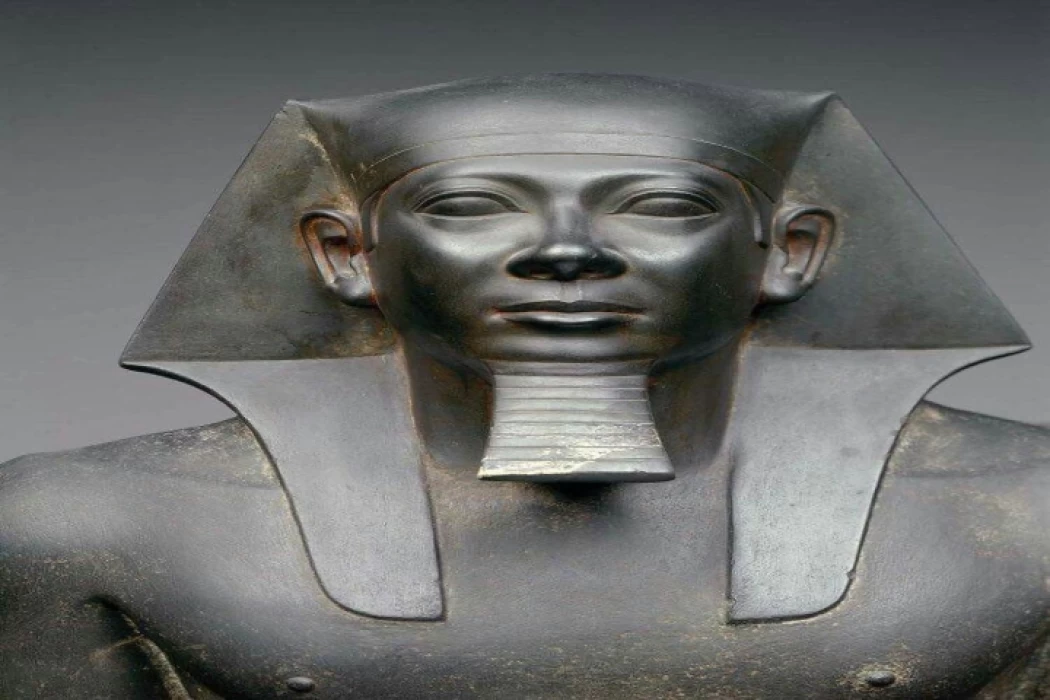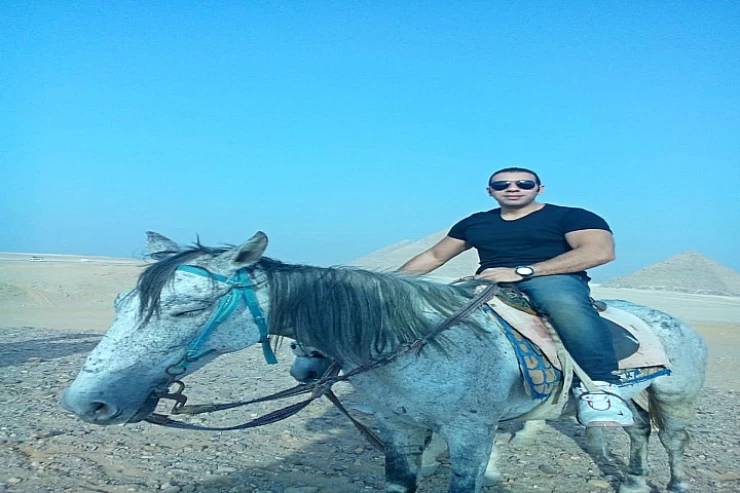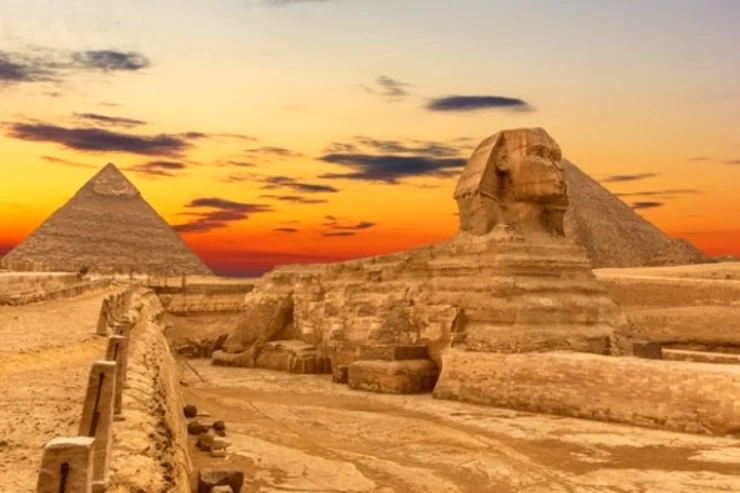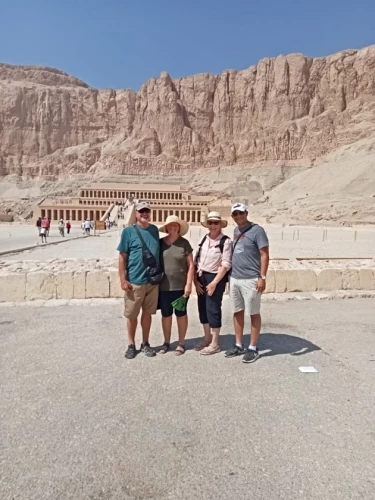
King Menkaure | Mycerinus
King Menkaure | Mycerinus Pyramid
In the Egyptian language, the Pyramid of Menkaure was referred to as "Netjer-er-Menkaure," or "Menkaure is divine." This refers to the king for whom this pyramid was constructed to serve as a tomb for his afterlife.He is the builder of the third greatest pyramid in the Giza Necropolis, which ended a great era of architectural magnificence. The Pharaoh is considered to be the son of King Chephren and Queen Khamernebti I. He got married young to his sister, who had become the future queen, Khamernebti II. She bore him a son called Khunre, who probably died at a very young age.
Menkaure was the king who built the third pyramid; in ancient Egyptian, "Netjer-er-Menkaure," "Menkaure is Divine," is what this king's pyramid was referred to in the ancient Egyptian tongue. It is also the termination point in monumental constructions at Giza for a pyramid meant as an afterlife tomb. Menkaure, also called Mycerinus, was born of King Khafra and Queen Khamernebti I. He married Khamernebti II, who became a queen after having a son who was named Khunre and who likely died young. His other son was called Shepseskaf, who succeeded him, and one daughter, Khentkaus I, who probably married Userkaf, the first king of the Fifth Dynasty. No predecessor of Menkaure had ever been rated as wise and benevolent king by the populace, and as such his pyramid was not of much greater size.
However, one could say that the scaling down probably had no solid reason backing it; rather, speculations from a few commentators could turn the economy over it, or that some changed religious ideas that increasingly put funerary temples above erectile pyramids, or even too rigid as the Giza Plateau started to get crowded. The pyramid remained incomplete on the death of Menkaure, as it was finalized under Shepseskaf; the upper part was clad in fine limestone while the lower portion remained harsh granite. Cairo Top Tours will take you on an exceptionally interesting trip to the Pyramids of Giza, including the stunning Great Pyramid of Khufu, the awe-inspiring Pyramid of Khafra, and the notable Pyramid of Menkaure. Also to be appreciated will be the Great Sphinx, the immortal guardian to all within the necropolis. All this will be under the guidance of expert guides who will inform you of the history, culture, and traditions of ancient Egyptians while giving you the perfect possible chance to capture moments to remember at these historic sites.
One could say that scaling down had no solid reason to back it; merely speculation from a few commentators could turn the economy about, or that some changed religious ideas increasingly placed funerary temples above pyramids in terms of erection, or else too rigid as the Giza Plateau began to get crowded. The pyramid was left incomplete at the death of Menkaure and was seen through to completion under Shepseskaf; the upper part of this was clad in fine limestone, while the lower slots were left in rough granite. A trip to Cairo Top Tours promises a high-interest overview of the Pyramids of Giza, including the stunning Great Pyramid of Khufu, the awe-imposing Pyramid of Khafra, and the noteworthy Pyramid of Menkaure. Also included will be the Great Sphinx, an everlasting guardian of all in the necropolis. All this will be under the experienced guides who will narrate to you the history, culture, and traditions of ancient Egyptians while giving you the best possible chance to capture moments to immortalize at these historical sites.
There is no solid ground for this scaling down, but some commentators suggest that it is due to economic reasons, that or some changed religious outlook now putting funerary temples above pyramid size, or due to practical reasons as the Giza Plateau started getting crowded. The pyramid remained unfinished upon Menkaure's death and was completed by Shepseskaf, with its upper part clad in fine limestone while the lower portion was left in rough granite. Cairo Top Tours will take you on a really interesting journey to the Pyramids of Giza, including the wonderful Great Pyramid of Khufu, the majestic Pyramid of Khafra, and also the famous Pyramid of Menkaure. You will also be privileged to admire the Great Sphinx, the immortal guardian of all within the necropolis. All this should be done under the guidance of expert guides who will inform you about the history, culture, and traditions of ancient Egyptians while giving you a chance to capture moments to remember at these historic sites.
All in all, the scaling down could not have had any ground as above; it is only speculation by some commentators on economic reasons behind it or some changed religious orientation that increasingly valued funerary temples compared to pyramid size or even due to practical restrictions as the Giza Plateau began to get crowded. The pyramid remained unfinished at Menkaure's death and was finally completed under Shepseskaf, the upper part of which was clad in fine limestone, whereas the lower was left in rough granite. Cairo Top Tours will take you on the most thrilling trip to the Pyramids of Giza, including the great Great Pyramid of Khufu, the awe-inspiring Pyramid of Khafra, and the well-known Pyramid of Menkaure. The Great Sphinx, eternal guardian of all within the necropolis, will also be featured. All this under a team of guides highly skilled in enriching
King Mycerinus married two other wives, but none of their names are known to historians. He had a son from one of these wives; they named the young prince Shepseskaf, who succeeded his father on the throne of Egypt, and he had a daughter from the other one, Khentkaus I, who may later have married Userkaf, the first king of the 5th Dynasty.
Best Works of King Mycerinus:
Contrary to Cheops and Chephren, Mycerinus was later seen as a generous and wise king. This may have been caused by the fact that his pyramid, built next to the pyramids of Cheops and Chephren at Giza, was slightly less than half the size of these two great pyramids.
If it is true that we have not received any explanation that indicates the reasons for such a sudden and noticeable decrease, there are nevertheless possible reasons. For example, we can guess that since most of the real craftsmen were busy building temples and sculpting statues, Mycerinus' resources were now reduced to the bone; moreover, the construction of five great pyramids during the previous four kingdoms had certainly emptied the royal treasuries.
It is also possible that Mycerinus has not felt the need for a pyramid of colossal dimensions at all. A change in theological conceptions related to death could have meant that funerary temples were considered more important than the actual tomb, and in fact, the funeral temple of Mycerinus is relatively large compared to its pyramid; it could simply be that the plateau of Giza began to be overcrowded or perhaps that the pharaoh, doubting his survival, had decided to be cautious.
The pyramid of Mycerinus, as you can see on the tour of the Giza Pyramids, was not completed when Mycerinus died and was only partially completed by his successor, Shepseskaf. The upper part was finished in the now-traditional fine limestone from Turah, but 16 courses at the bottom were left undressed.
It seems to indicate, at least for the pyramid of Mycerinus, that the outer casing was laid from top to bottom, probably while removing the ramp that was used to haul the heavy blocks of red granite to the top.
Cairo Top Tours will help you visit the three pyramids, including that of Pharaoh Menkaure, the smallest pyramid; King Khufu, which is one of the Seven Wonders of the World; and that of Pharaoh Menkaure, which is the middle pyramid. Have a chance to see the Great Sphinx, the past guardian of the tombs. Would not leave out the tour guide to help you learn about Egypt's history and her civilizations along with the most famous customs and traditions of the nimble-fingered ancient Egyptians. In addition, our representative shall help you take pictures that will be unforgettable.
In the Egyptian language, the Pyramid of Menkaure was referred to as "Netjer-er-Menkaure," or "Menkaure is divine." This refers to the king for whom this pyramid was constructed to serve as a tomb for his afterlife.He is the builder of the third greatest pyramid in the Giza Necropolis, which ended a great era of architectural magnificence. The Pharaoh is considered to be the son of King Chephren and Queen Khamernebti I. He got married young to his sister, who had become the future queen, Khamernebti II. She bore him a son called Khunre, who probably died at a very young age.
Menkaure was the king who built the third pyramid; in ancient Egyptian, "Netjer-er-Menkaure," "Menkaure is Divine," is what this king's pyramid was referred to in the ancient Egyptian tongue. It is also the termination point in monumental constructions at Giza for a pyramid meant as an afterlife tomb. Menkaure, also called Mycerinus, was born of King Khafra and Queen Khamernebti I. He married Khamernebti II, who became a queen after having a son who was named Khunre and who likely died young. His other son was called Shepseskaf, who succeeded him, and one daughter, Khentkaus I, who probably married Userkaf, the first king of the Fifth Dynasty. No predecessor of Menkaure had ever been rated as wise and benevolent king by the populace, and as such his pyramid was not of much greater size.
However, one could say that the scaling down probably had no solid reason backing it; rather, speculations from a few commentators could turn the economy over it, or that some changed religious ideas that increasingly put funerary temples above erectile pyramids, or even too rigid as the Giza Plateau started to get crowded. The pyramid remained incomplete on the death of Menkaure, as it was finalized under Shepseskaf; the upper part was clad in fine limestone while the lower portion remained harsh granite. Cairo Top Tours will take you on an exceptionally interesting trip to the Pyramids of Giza, including the stunning Great Pyramid of Khufu, the awe-inspiring Pyramid of Khafra, and the notable Pyramid of Menkaure. Also to be appreciated will be the Great Sphinx, the immortal guardian to all within the necropolis. All this will be under the guidance of expert guides who will inform you of the history, culture, and traditions of ancient Egyptians while giving you the perfect possible chance to capture moments to remember at these historic sites.
One could say that scaling down had no solid reason to back it; merely speculation from a few commentators could turn the economy about, or that some changed religious ideas increasingly placed funerary temples above pyramids in terms of erection, or else too rigid as the Giza Plateau began to get crowded. The pyramid was left incomplete at the death of Menkaure and was seen through to completion under Shepseskaf; the upper part of this was clad in fine limestone, while the lower slots were left in rough granite. A trip to Cairo Top Tours promises a high-interest overview of the Pyramids of Giza, including the stunning Great Pyramid of Khufu, the awe-imposing Pyramid of Khafra, and the noteworthy Pyramid of Menkaure. Also included will be the Great Sphinx, an everlasting guardian of all in the necropolis. All this will be under the experienced guides who will narrate to you the history, culture, and traditions of ancient Egyptians while giving you the best possible chance to capture moments to immortalize at these historical sites.
There is no solid ground for this scaling down, but some commentators suggest that it is due to economic reasons, that or some changed religious outlook now putting funerary temples above pyramid size, or due to practical reasons as the Giza Plateau started getting crowded. The pyramid remained unfinished upon Menkaure's death and was completed by Shepseskaf, with its upper part clad in fine limestone while the lower portion was left in rough granite. Cairo Top Tours will take you on a really interesting journey to the Pyramids of Giza, including the wonderful Great Pyramid of Khufu, the majestic Pyramid of Khafra, and also the famous Pyramid of Menkaure. You will also be privileged to admire the Great Sphinx, the immortal guardian of all within the necropolis. All this should be done under the guidance of expert guides who will inform you about the history, culture, and traditions of ancient Egyptians while giving you a chance to capture moments to remember at these historic sites.


















